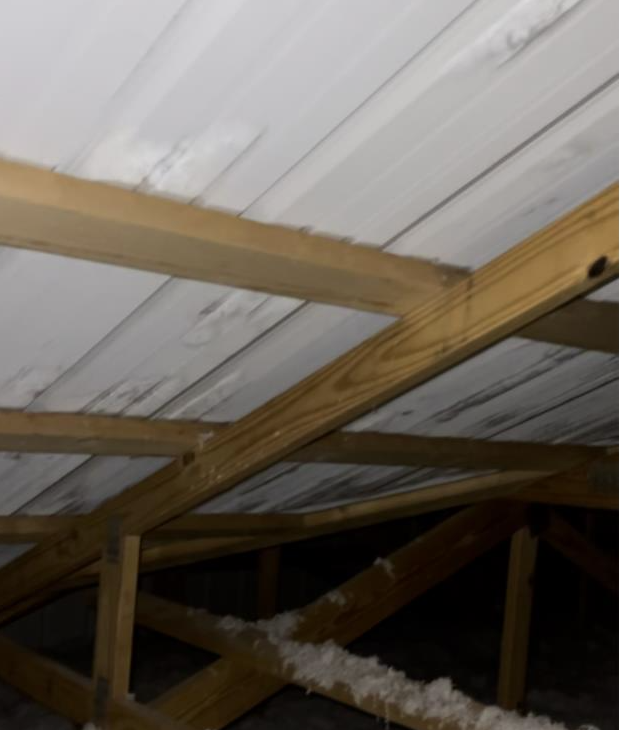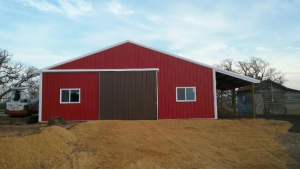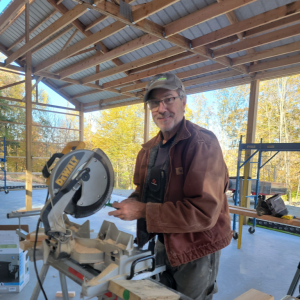Builder Placed no Vapor Barrier Between Purlins and Roof Steel
Almost client ALEX in CLINTON writes:
“I recently had a pole barn home built and after we moved in we discovered our roof does not have any form of vapor barrier, just metal right on top of the purlins. Our contractor stated the entire attic is heavily ventilated so the barrier was not needed, which I did not agree. After going back and forth he offered to fix it only one way. Which would be to take fanfold insulation board between each rafter. I felt this would only hide my condensation problems rather than fix it. My question is, would this be a viable option? As well I’ve looked into adding in ventilation fans in the attic to better control the moisture, thoughts on that as well please!”
Mike the Pole Barn Guru responds:
You have just hit on one of my top peeves when it comes to post frame building contractors and providers – pretending condensation is not going to occur under bare steel roofing installed directly over roof purlins.
And (even though you did not invest in a Hansen Pole Building) I have to feel we are partially at fault here.
Why?
Our mission is to assist potential clients so they avoid making crucial errors they will regret forever. In looking back through our records, when you discussed your building needs with us two years ago, we failed – we did not convey to you how important some sort of roof steel condensation control is (at least we neglected to include it in our quotes).
So now you are left with having spent a great deal of your hard-earned money (or future years of making mortgage payments with hard-earned money) and a home built almost right.
Let’s start with discussing “heavily ventilated”. To begin with, there is no realistic amount of airflow through an attic capable of eliminating all possibility for condensation. Attic ventilation systems, by Building Code, are very specific as to not only required ventilation, but also correct ratios of intake and exhaust to create proper airflow from eave to ridge. These requirements are based upon building science and studies done on actual full-sized attics. Chances are more than good, your contractor has over done either soffit intakes or ridge exhausts. He or she probably has even used vented soffit in gable end overhangs (sure to mess up proper airflow).
You can educate yourself further on ventilation requirements here: https://www.hansenpolebuildings.com/2023/06/274512/
| 2018 IRC Attic Ventilation Requirements – Hansen Buildings
Hansen Pole Buildings’ reader asks Mike the Pole Barn Guru how much of the ridge of a pole building ridge needs to have vented closures. www.hansenpolebuildings.com |
Attic ventilation fans, short of creating a wind tunnel, are not going to resolve future challenges.
While your contractor’s proposed solution is sort of right, it would only work if an absolute 100% air seal was achieved. Face it, this is just not going to happen.
So, what are your options?
Easiest would be to have two inches of closed cell spray foam applied directly to the underside of your roof steel.
All other options involve removing roof steel and placing a well-sealed thermal break between roof purlins and roof steel, then reapplying roof steel. Roof steel should be either shifted slightly to right or left to not place same sized screws back into same holes in wood (and original screws should not be used), or to use larger diameter, longer screws. This would be a good time to make sure replacement screws are all powder coated with EPDM gaskets.
What would give a capable thermal break?
Fan-fold insulation, reflective radiant barriers and faced metal building insulation are all possible options – provided all seams are tightly sealed. Solid sheathing roof with OSB (Oriented Strand Board) or plywood with either 30# felt or a synthetic ice and water shield between sheathing and roofing would also be a possibility.
Hopefully you have not made your final payment to your builder, so you as yet have some amount of leverage. However unless this was addressed specifically in your contract documents (we do address it in ours) chances are you are looking at some significant out of pocket expense to cure something easily and affordably solved at time of construction.

 Well, one of our steel vendors (who does a fabulous job at getting the right pieces, in the right quantity to hundreds of our clients annually) had one of those “no idea” moments recently and we ended up with a couple of good-natured clients who just could not get the track covers they were sent to fit….because they were bent to the wrong profiles!
Well, one of our steel vendors (who does a fabulous job at getting the right pieces, in the right quantity to hundreds of our clients annually) had one of those “no idea” moments recently and we ended up with a couple of good-natured clients who just could not get the track covers they were sent to fit….because they were bent to the wrong profiles! One of the places some builders will cut corners, is one which should be the most obvious – doors. Hundreds of dollars per door can be pocketed, with building owners none the wiser until problems occur down the road. Primed steel entry doors are available at several popular “big box” locations for just over $100. Hung in bare wood jambs, unless the entire assembly is promptly painted and then frequently repainted, they degrade quickly. Sliding doors, yes they slide, but made of wood they will be heavy, as well as prone to warping and twisting. One chain store markets a name brand steel sectional overhead door, with parts which have been “cheapened” – lower grade hinges and brackets and low cycle springs. Dutch doors? Built from all wood, they have a lifespan measured in months, not years, especially when not hung in heavy duty steel jambs.
One of the places some builders will cut corners, is one which should be the most obvious – doors. Hundreds of dollars per door can be pocketed, with building owners none the wiser until problems occur down the road. Primed steel entry doors are available at several popular “big box” locations for just over $100. Hung in bare wood jambs, unless the entire assembly is promptly painted and then frequently repainted, they degrade quickly. Sliding doors, yes they slide, but made of wood they will be heavy, as well as prone to warping and twisting. One chain store markets a name brand steel sectional overhead door, with parts which have been “cheapened” – lower grade hinges and brackets and low cycle springs. Dutch doors? Built from all wood, they have a lifespan measured in months, not years, especially when not hung in heavy duty steel jambs.





